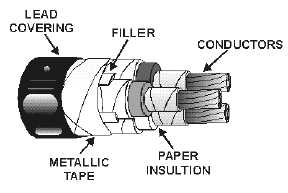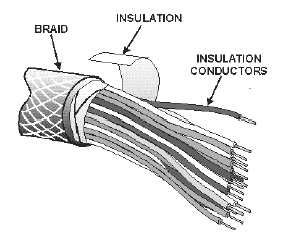1-19
cable. Over this, a lead sheath is applied. This type of cable is used on voltages from 10,000 volts to
35,000 volts.
Figure 1-11.—Paper-insulated power cables.
Q27.
What are the most common insulators used for extremely high voltages?
Silk and Cotton
In certain types of circuits (for example, communications circuits), a large number of conductors are
needed, perhaps as many as several hundred. Figure 1-12 shows a cable containing many conductors.
Each is insulated from the others by silk and cotton thread. Because the insulation in this type of cable is
not subjected to high voltage, the use of thin layers of silk and cotton is satisfactory.
Figure 1-12.—Silk and cotton Insulation.
Silk and cotton insulation keeps the size of the cable small enough to be handled easily. The silk and
cotton threads are wrapped around the individual conductors in reverse directions. The covering is then
impregnated with a special wax compound.
Enamel
The wire used on the coils of meters, relays, small transformers, motor windings, and so forth, is
called magnet wire. This wire is insulated with an enamel coating. The enamel is a synthetic compound of
cellulose acetate (wood pulp and magnesium). In the manufacturing process, the bare wire is passed
through a solution of hot enamel and then cooled. This process is repeated until the wire acquires from 6
to 10 coatings. Thickness for thickness, enamel has higher dielectric strength than rubber. It is not





